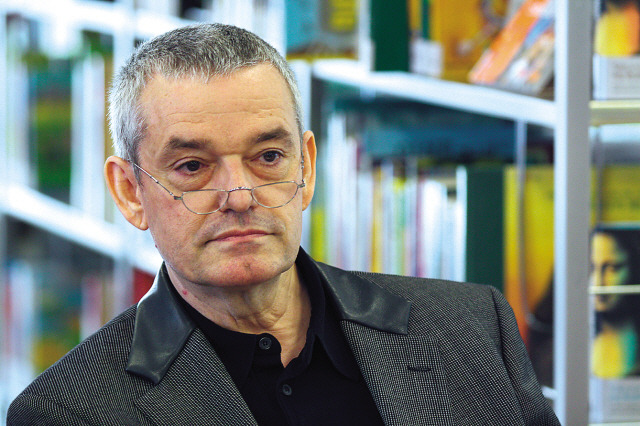German fantasy writer Ralf Isau grew up listening to his father’s stories and harmonica.
“I think that’s how I developed my love for the fantasy genre,” the writer said in a press conference in Seoul on Monday. “When I was a child, my art teacher wrote on my report card that my paintings have ‘a lot of fantasy elements.’”
The 57-year-old writer, famous for his friendship with the late German author Michael Ende (1929-1995), visited Seoul this week to promote the recently released Korean edition of his 2005 novel “Die Galerie der Lugen” (The Gallery of Lies). The sci-fi thriller is set in London in 2007 and deals with hermaphroditic clones.
“I don’t think the genre of fantasy makes the readers escape their reality,” the author told reporters through a German-Korean interpreter. “It in fact makes them have a better grasp of it. The genre lets people see things without prejudice. And it gives them new perspectives of the world they live in. That is why fantasy is important.”
 |
German writer Ralf Isau speaks during a press conference in Seoul on Monday. (Minumsa) |
The author, who used to work as an IT engineer, started writing as he wanted to give a work of fiction to his young daughter, who was 9 at the time, as a gift. Having grown up listening to his father’s stories ― mostly about his own experience surviving World War II as a young man ― Isau, too, wanted to tell his daughter stories that inspire.
“Instead of telling her ‘do this’ or ‘do that,’ I wanted to give her a story to think about ― an orientation to life,” he said.
He started writing the novel in 1988, thinking it wouldn’t take him too long to finish. But he ended up completing the work in 1994, seven years after he started it. His daughter was no longer a child at this point ― she was 16. He published the novel “Der Drache Gertrud (The Dragon Gertrud)” in 1994, and then decided to become a full-time writer.
Isau also talked about his first encounter with Ende, whose works, including his 1974 novel “Momo,” are much loved by local readers here. Their first meeting took place during Ende’s book reading event in 1993 in Stuttgart.
“My wife’s legs were broken at the time,” Isau said. “So we would not have been able to attend the event if the reading event took place somewhere far. I went because it was held in Stuttgart where I lived. I gave Ende a piece of my writing as a gift and he liked what he read.”
It was Ende who introduced Isau to his publisher, which helped him build his career as an up-and-coming writer. “I later wrote Ende a thank-you letter,” Isau said. “He wrote me back, saying he was glad to be a stepping stone in my career.’”
When asked how his experience working in Germany’s IT industry influences his writing, Isau said it helped him organize the narratives and structures of his novels.
“Novels (just like machines) have structures,” he said. “If you don’t do your first chapter right, it can actually affect the later chapters as well. Working in the IT industry helped me to think systematically.”
Since 1994, Isau has published some 40 novels. “All of my novels have one thing in common,” the author said. “And that is they encourage their readers to think independently, rather than just passively accept information. One cannot create something new if he or she keeps repeating the same over and over. People create when they form a new perception on their own.”
Published by local publishing house Minumsa, the two-volume Korean edition of his novel “The Gallery of Lies” is currently available in bookstores.
By Claire Lee (
dyc@heraldcorp.com)





![[Herald Interview] 'Trump will use tariffs as first line of defense for American manufacturing'](http://res.heraldm.com/phpwas/restmb_idxmake.php?idx=644&simg=/content/image/2024/11/26/20241126050017_0.jpg)

![[Herald Review] 'Gangnam B-Side' combines social realism with masterful suspense, performance](http://res.heraldm.com/phpwas/restmb_idxmake.php?idx=644&simg=/content/image/2024/11/25/20241125050072_0.jpg)
![[Health and care] Getting cancer young: Why cancer isn’t just an older person’s battle](http://res.heraldm.com/phpwas/restmb_idxmake.php?idx=644&simg=/content/image/2024/11/26/20241126050043_0.jpg)